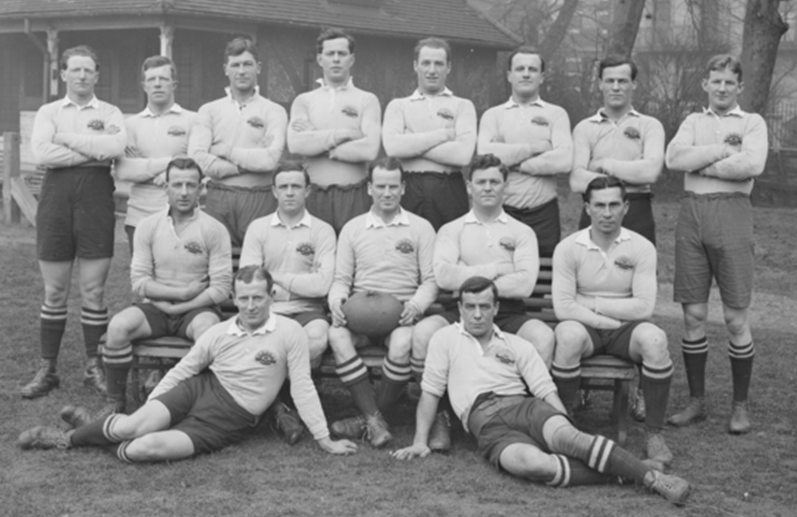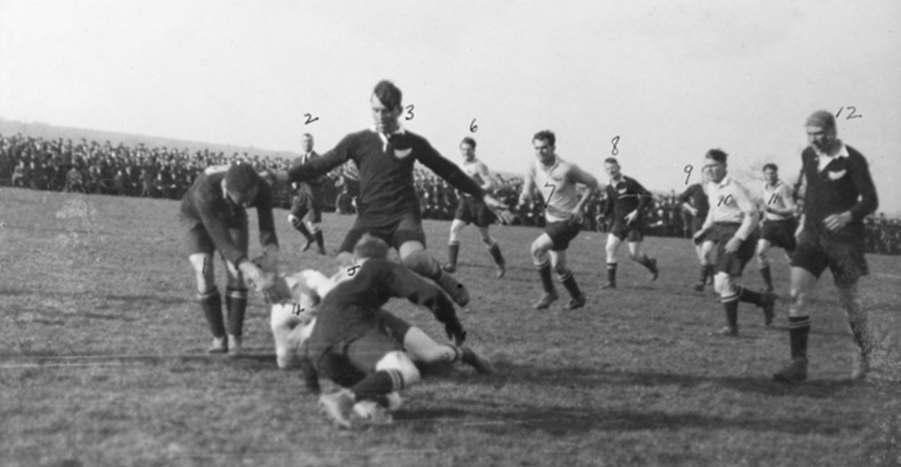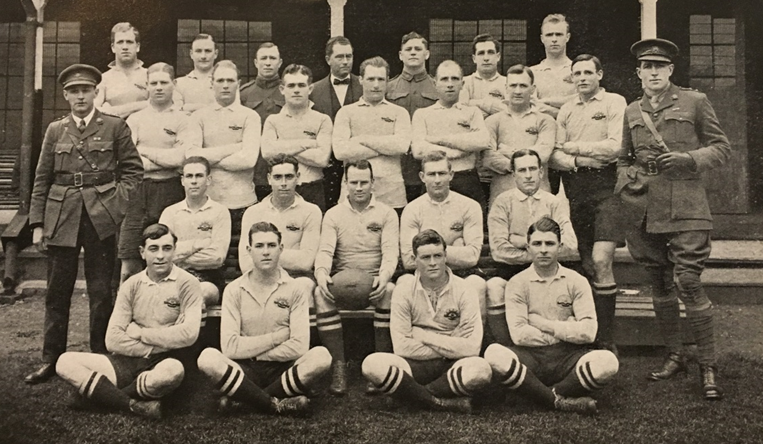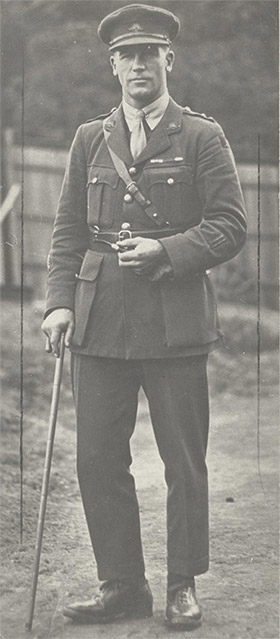When the First World War ended on 11 November 1918 Allied military authorities were keen to ensure that the millions of soldiers awaiting repatriation and demobilisation across Europe were appropriately occupied and that the reputation of the force not be undermined by ill-disciplined behaviour. The challenge was particularly acute for Australian, New Zealand, Canadian, South African and Indian soldiers as shipping to take them home was scarce. General Sir John Monash had command of over 200,000 Australian troops in France and the wait was unfortunately going to be longer than hoped.
The Australian Imperial Force (AIF) commanders quickly placed emphasis on encouraging all forms of healthy sport during the immediate post-Armistice period. A flurry of inter-platoon and inter-company competitions in France, Belgium, England and the Middle East got underway. Up to then any matches had been limited to within units while they were resting from serving in the front lines.
Early in January 1919, the AIF received an invitation to play the French Army XV in Paris on the 19th of that month. Time to select and prepare an Australian XV was short, so the five Australian Divisions were asked to each nominate their eight best players (four forwards and four backs). The selectors were Colonel Thomas Blamey, Lieutenant Colonel Robert Massie and Major (Doctor) ‘Wally’ Matthews.
Matthews was chosen to manage the squad which concentrated at a School of Physical and Recreational Training at Barbencon near Charleroi in Belgium. Former Wallaby James ‘Jimmy’ Clarken and uncapped Wallaby Munro ‘Munnie’ Frazer were appointed coaches.
Massie was regarded as Australia’s finest all-round athlete before the war and put the squad through a very strenuous two weeks of training and trials. The squad played two matches against each other every day.
From this squad a team of 19 was selected and became known as the AIF ‘Trench’ Team. The match against the French Army XV was an excellent spectacle of hard, fast rugby – despite the chilly conditions. The score of 6-3 in favour of the AIF Trench Team hardly reflected their overall superiority. The Australians were consistently on the offensive during the match and it was only their lack of concerted action as a team that prevented them capitalizing on the opportunities they created. The shortness of the time spent training together was distinctly apparent. Credit on the other hand must be given to the determined defensive efforts of the French Army XV who repulsed numerous onslaughts against their line.
At a meeting in the War Office in Whitehall in late January 1919, it was agreed that there were sufficient players of quality available to institute an Inter-Service and Dominion Forces Rugby Competition.
A subsequent meeting of the various arms of both the Services and Dominions was held at the Junior United Services Club on 8 February 1919, where Australia was represented by Major ‘Wally’ Matthews, and final arrangements for the Competition made, dates and grounds allotted and fixtures drawn.
The Competition would include six teams: the New Zealand Army, the British Army (known during the competition as the Mother Country), the Australian Imperial Forces, the Canadian Expeditionary Forces, the South African Forces and the Royal Air Force.
King George V agreed to lend his insignia and status to the Competition, as he did for all the other major sports. From that time the Inter-Service and Dominion Forces Rugby Competition was more commonly called the ‘King’s Cup for Rugby’.
Each team would play each other over a period of weeks in varying locations around Britain. Once the teams had played each encounter, the two sides with the most wins would face each other for the right to play for the King’s Cup at Twickenham.
A sub-committee was appointed to direct the Australian effort, consisting of Major ‘Wally’ Matthews, Major Keith Norman and Lieutenant Leslie Seaborn, MC.
It now became necessary to select the best possible side to represent Australia. The AIF Headquarters Team in London had already played a number of matches against other Allied teams and done well, but there was also the AIF Trench Team which had beaten the French Army XV in Paris. Neither was regarded as an all-round first class combination, but both contained some excellent material.
So, on 28 January 1919, the AIF Trench Team travelled to England, where it met up with the AIF Headquarters Team. The combined squad was housed at Warwick Square, adjacent to the Westminster School, and trained on Chiswick Park. Each man in the squad was as hard as the next. Most had endured four long years of war; many had been wounded. They played not only for their country but for the many mates they had lost during the war. Any sense of survivor’s guilt was expressed in playing rugby as hard and fast as you possibly could.
On 12 February 1919 the two teams squared off in a match at Chiswick Park to assist selectors to compare talent. For this match the Trench Team renamed themselves as the ‘French’ Team and won by twelve points to six.
After a series of trials two new AIF teams were formed: the AIF First XV and what became known as the AIF Reserve Team. Major Wally Matthews would manage the AIF First XV which would compete in the King’s Cup for Rugby. Lieutenant William ‘Billy’ Watson, Military Cross and Bar, Distinguished Conduct Medal was appointed as the Team Captain of the AIF First XV. Blisters from Watson’s exposure to mustard gas were lanced with a pen knife before each match. Lieutenant Leslie Seaborn would manage the AIF Reserve Team which would tour the UK and Ireland. Some players moved between the two teams over the course of the next several weeks.
The draw for the King’s Cup resulted in Australia being pitted against the Mother Country at Leicester on 8 March 1919, South Africa on 15 March at Newport, New Zealand on 22 March at Bradford, the Royal Air Force on 29 March at Gloucester, and Canada on 15 April at Twickenham.
Under the direction of Major ‘Wally’ Matthews, the AIF First XV played a number of train-up matches and developed a healthy spirit of camaraderie. For the King’s Cup Competition the AIF Squad was issued with a light blue jersey with the AIF ‘Rising Sun’ badge on the left breast.
The first match on 8 March 1919 saw a disjointed Australian team lose to the Mother Country 6 to 3. On 15 March 1919 the Australian team started to gel and defeated South Africa 8 to 5.
According to the King’s Cup draw, the next match was to be against New Zealand at Bradford, England on 22 March 1919, but three inches of snow fell that day and the match was postponed until 9 April. Australia then played the Royal Air Force on 29 March 1919 and lost 7 to 3. Finally finding their form the Australian team then comfortably defeated Canada on 5 April 1919 38 to nil.
Up to this stage of the King’s Cup competition, New Zealand had won all four matches they had played, while the Mother Country had won three and had a good chance of beating South Africa. It only remained for the New Zealanders to beat the Australians in their match at Bradford, England and the King’s Cup would have been their property without having to play any more matches. The newspapers in the UK were almost unanimous in their opinions that New Zealand had the ability to win comfortably. However, the fast improving Australians were destined to be the fly in the New Zealand ointment.
The match played between Australia and New Zealand on 9 April 1919 before 7,000 spectators was the finest game of the King’s Cup Competition. The final score was six points to five in favour of the Australians and the winners were pressing very hard at the final whistle.
This match was the end of the King’s Cup Competition as far as the Australians were concerned. It was generally conceded that they had been unfortunate in not having struck their form earlier in the Competition. They defeated all the other Dominion teams in the contest by 52 points to 10 against; but the loss to the Royal Air Force was inexplicable.
The King’s Cup Competition was the first international rugby event involving several representative teams from the northern and southern hemispheres. It sowed the seed for a future Rugby World Cup, although it took over 60 years for that seed to germinate when the International Rugby Board finally approved an international rugby tournament in the mid-1980s.
The AIF Reserve Team provided some players to the AIF First XV during the King’s Cup Competition, but they also toured the United Kingdom in their own right between February and May 1919. Lieutenant Leslie Seaborn led and managed the AIF Reserve Team with great energy and Company Sergeant Major Peter Buchanan, after playing in the first King’s Cup match against the Mother Country, captained the AIF Reserve Team.
The AIF Reserve Team established a fine reputation as a rugby force to be reckoned with. The success of the Reserve Team was impressive. Of all their victories the most remarkable was their win over Llanelly at Llanelly’s home ground on 15 March 1919, the first time this had ever been done by a touring team. Llanelly took their revenge in two subsequent matches on 12 April and 13 May 1919, but the AIF Reserve Team’s great win must go down as an historic moment in Australia’s rugby annals.
By late May 1919 the two AIF rugby union teams had played twenty-eight matches across the United Kingdom. Over 40 players had had the opportunity to play at an international level and in doing so contributed to re-energising the popularity of Rugby Union in the UK. Their exploits had been followed avidly in the Australian Press and pressure soon mounted for them to tour the major Australian rugby centres on their return home.
Returning to Australia the AIF Team played eight matches in NSW and Queensland – scoring 268 points with 78 scored against them. In every sense, the AIF Team’s tour of Australia was a resounding success and morale booster for Rugby Union in Australia in the immediate post-war period. It was remarkable that the AIF veterans still had the capacity for tough and vigorous play after the basic diet, privation, stress and difficulties faced by them during years of active service. It was their last ‘hurrah’ as ‘comrades in arms and in rugby’ and when they separated to return to their homes – their war was, finally, over.
The Australian Army Rugby Union (AARU) traces its origins to the 1919 AIF Rugby Union teams and in 2019 will celebrate its Centenary year. The AARU not only embodies the spirit of the 1919 AIF teams, it continues to build on their tradition of resilience, tenacity and team work.

Back row (left to right): Lance Corporal John ‘Bluey’ Thompson; Corporal Thomas ‘Tom’ Stenning; Lieutenant William ‘Billy’ Watson; Lieutenant Ernest ‘Bill’ Cody; Sergeant Joseph Murray; Lieutenant William ‘Roger’ Bradley; Corporal Arthur ‘Togo’ Lyons; Captain Bruce ‘Jackie’ Beith.
Middle row: Quartermaster Sergeant John ‘Plumb’ Bond; Corporal John ‘Darb’ Hickey; Company Sergeant Major Peter Buchanan; Gunner Jack Watkins; Sergeant Godfrey ‘Babe’ See.
Front row: Corporal Dudley ‘Dud’ Suttor; Private Thomas ‘Rat’ Flanagan.
(AWM D00373)

Identified: 1. A. Wilson, New Zealand (NZ); 2. Referee Mr Yeadon; 3. Private A. Singe, NZ forward; 4. Captain Bruce ‘Jackie’ Beith; 5. unidentified NZ forward; 6. Sergeant Joseph Murray; 7. Corporal Vivian ‘Viv’ Dunn; 8. R. Sellars, NZ; 9. unidentified NZ, obscured; 10. Lieutenant Horace ‘Dick’ Pountney; 11. Lieutenant Ernest ‘Bill’ Cody; 12. Ernest Belliss, NZ.
(AWM D00535K)

Back row (left to right): unidentified; unidentified; Driver James ‘Jimmy’ Clarken (in uniform); unidentified; Gunner James ‘Jimmy’ Bosward; Lieutenant William ‘Roger’ Bradley; Sergeant Joseph Murray; Corporal Vivian ‘Viv’ Dunn; Lieutenant Ernest ‘Bill’ Cody; Corporal Arthur ‘Togo’ Lyons; Sergeant Godfrey ‘Babe’ See.
Middle row: Major (Doctor) ‘Wally’ Matthews (in uniform); unidentified; unidentified; Lieutenant Irving ‘Irv’ Ormiston, Sergeant Joseph Murray; unidentified; unidentified; unidentified; unidentified; Lieutenant Leslie Seaborn (in uniform).
Front row: unidentified; unidentified; Company Sergeant Major Peter Buchanan; unidentified; Corporal Joseph Stevenson.
On ground: unidentified; unidentified; unidentified; unidentified.
(Soldiers and Sportsmen)

Contact Marcus Fielding about this article.






